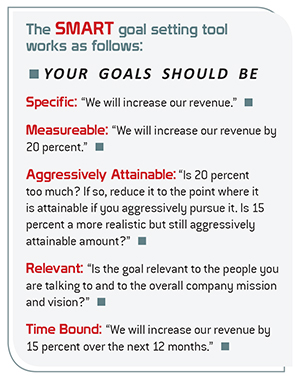 BY BRETT TYSON
BY BRETT TYSON
Leading a team while also having the operational deliverables resting on your shoulders can be a daunting task. Those of us who are managers have been stretched by this task and let’s face it, we have not always done well. It’s not hard to figure out. When there isn’t time to do everything on our plates, everyday seems like a whirlwind. When we are constantly running to put out the fires and fix the mistakes we did not see coming, something gets missed. I have lived this life, and I did not like it.
Last month I discussed three steps to a better performing company. In this article, I will illustrate the ways out of this world of chaos so that your company is more manageable for your trusted employees. The concrete strategies that I discuss are taught to operations managers every day to help them get in—and stay in—control. To be a successful leader and manager, you must be able to set aside the things that aren’t as important so you can carve out a path to achieve the results you want.
At the very beginning of any strategically successful endeavor is clear goal setting. You must know what you want. Many managers are not clear with staff about this, and then they wonder why their employees struggle. Clear goal setting needs to follow some basic rules to be effective, and one method that I really like is the SMART tool, which allows you to make sure your goals will hold up and serve your interests. This is a great activity to do with your staff as it a solid teambuilding exercise that will get everyone focused on the path forward. Sharing the Goal With Your Workforce

When I look at a goal like this, I see it as a very attainable thing as long as the entire company is moving in the same direction toward the same milestone. For the reservations team, their individual goal could read like this: “The reservations team will increase our out-of-state upsells by 5 percent over the next four months. Additionally, we will increase the amount of meet and greets sold by 5 percent over the next four months. These two goals will be repeated three times over the next 12 months ending in an increase in revenue of [fill in the amount here].” It is important that you do this final calculation to see if that contribution is enough to meet the bigger goal of increasing revenue by 15 percent over the next 12 months. Some managers will look at this and say, “This is too ambitious and a lot of work.” They are right, it is work. This, however, is the beginning of you controlling your world. You must control the process. If you don’t, the process will control you, and that is a miserable and stressful place to be. Sometimes managers have to proceed with these activities even when things are stressful. The more activities you have that are within your control, the more you will squeeze out the unpredictable activities that absorb your time.
I have often heard that first you have to fix the service issues before you can tackle these bigger, pie-in-the-sky goals. Don’t fall into this trap. The activities that you introduce and build should be relevant to your day-to-day operations, and will be the things that actually eliminate the chaos.
Here’s another example for your chauffeur staff. You have identified service areas that need to be addressed, including consistency of dress and vehicle cleanliness. But in addition, you have also established a clear company-wide goal of increasing revenue by 15 percent over the next 12 months. The chauffeur manager and his team have come up with the following way to successfully meet that challenge: “The chauffeur team will engage with as many passengers as possible to see if there are additional opportunities for expanding accounts. Each chauffeur will provide at least two possible leads in the weekly meeting. This will be done for three months.” If this were a real goal, there would need to be limitations on how this information was solicited, may involve some types of incentives, and could be a program you only use with your senior chauffeur team.
Weekly Meetings Reinforce the Goal and Address Other Issues
Notice that in the last example we didn’t first fix the service problems and then implement the goal. That’s because people are always more likely to change their behaviors when there is a meaningful context behind it. That’s not to say that the service issues will be swept under the carpet and ignored. Use weekly meetings to remind chauffeurs of professionalism and proper procedures while helping each department to focus on the goal at hand. Your chauffeur manager should discuss these issues candidly to frame the issue in the context of the goal. For example, your chauffeur manager could detail why this compromises your ability to meet your goal, but if successful, will bring in additional customers and put money in their pockets. At the end of the day, people want to believe in something and know what’s in it for them. That’s not a bad thing. That’s OK. You want your employees to feel connected to their company and that their hard work directly benefits them as well.
Let’s talk about the content of these meetings. For individual meetings, you need to have a predictable agenda so that your employees can prepare for it. I expect the people who I am supervising to walk into my office fully prepared for the meeting. The predictability of the meeting helps people focus their efforts and report on their deliverables effectively. With some managers that I supervise, I have them create a supervision form that they must bring to every meeting so that all the top level issues remain on the table every week. These one-on-one meetings are not only about work. They are also about personal connections. It’s important to find out how people are doing emotionally with their job and to listen to their stressors, complaints, confusions, concerns, etc. If you listen well, you will know how much each person can handle and the result will be employees whose ability and workload are well matched. A 30-minute meeting can be highly effective if you structure it well. I believe weekly meetings are best, but if they happen every other week, that will work.
Team meetings are also invaluable tools. These group meetings serve a number of functions. They are an excellent arena for you to develop and reinforce the culture of your company. You can develop norms and values here and develop unspoken expectations for the team. The team meetings are also a place where we revisit the goals every time you meet. The agenda should be focused around the main goals and the top deliverables. Once again, the agenda should remain the same each week so that each person or manager knows what he should report on. Meetings drive the operation forward. Use them well and take the time to prepare for them.
Stop, Look, Listen, and Think
Let’s talk about an important concept that often gets missed. When you ask an operations manager what his job is, listen carefully to what he decides to emphasize. He more often than not places most of the emphasis on the administrative tasks that he does to keep the departments busy. I have seen managers create administrative work that then consumes them. It’s almost as if newer managers somehow feel that they need to have a lot of this kind of work, this busy work that doesn’t directly benefit the manager or the company as a whole. If you have an operations manager working for you, he needs to keep the administrative work to an absolute minimum, and his biggest focus MUST be the people. His primary function should be to develop intimate working relationships with all of his employees. If he doesn’t, he will not be able to achieve those aggressive goals.
So how do you build intimate relationships? You observe what the different departments are doing and use one-on-one and group meetings to give them feedback and discuss progress. Sounds simple, right? Well, this is one of the areas I have seen managers struggle with the most. First, managers struggle to find the time to meet with people individually and then as a group. If they’re not working, who will run the show?
The concept I spoke about earlier must prevail again. Even though you are busy, you must develop processes and mechanisms to work through the chaos. The more you meet with your people and provide constructive feedback, and the more they develop an intimate, trusting, and professional relationship with you. That will then make it easier to have the team solve problems and work to their highest potential. This is a step you cannot overlook. If you don’t build those relationships, you are going to be working with broken tools.
Never forget that our companies are built with the people who work for us. I have talked a lot about building these intimate professional relationships. I have used the word “intimate” purposefully because the relationships need to be strong for you to leverage individuals and teams to their highest performance. If you have ever been part of or led a fully engaged and high-performing team, you know what the impact is. It’s incredible what you can achieve.
It can be overwhelming as managers to effectively lead a team of people while also dealing with all the other issues that get mixed in the fray. You might be surprised to learn that it starts with having a collective goal as a company, and parsing that goal with each of the departments so that it is attainable. Setting goals helps employees not only feel connected to the company’s success, but often help them understand the ‘why’ behind the procedures and policies you have in place. The few ideas I have laid out are some of the most basic and powerful tools available to you. Use them well and you will enjoy the success they bring you.”
[CD05/13]
Brett Tyson is the Director of Organizational Development for Harrison Global in Massachusetts. He can be reached at btyson@harrisontrans.com.

